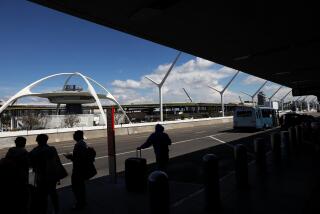La Jolla’s Science Applications Agrees to Rush Production of Bomb Detector at FAA’s Request
San Diego-based Science Applications International Corp. agreed Friday to a request to speed production of a new and highly accurate device that can detect bombs similar to the plastic explosive used in the Dec. 21 bombing of Pan Am Flight 103, which killed all 259 people on board and 11 people on the ground in Lockerbie, Scotland.
The Federal Aviation Administration, which in August signed an $8.5-million order for five of the detection devices, asked the La Jolla company to push up the delivery date for the first device by six months to mid-1989, according to SAIC Vice President Tsahi Gozani.
SAIC, which developed the devices in its Santa Clara, Calif., laboratories, hopes to deliver the remaining units by the end of 1990. The FAA has signed an option to acquire five more units.
“We’re scratching our heads right now trying to find ways to accommodate the FAA,” Gozani said. SAIC also is studying alternatives that would increase the company’s manufacturing capacity in Santa Clara.
95% Effective
The detection devices were 95% effective during recent tests at Los Angeles International and San Francisco airports, according to Gozani. The two prototype units scanned about 600 pieces of baggage an hour, he said.
The FAA has funded research that could lead to other detection technologies, but “this is the one that really looks good,” according to Tim Neale, a spokesman for the Airline Transport Assn. (ATA), a Washington, D. C.-based trade group. “They’re far enough along on development that we can expect to see them in airports fairly soon.”
SAIC’s unit is “extremely effective in detecting all types of explosives in quantities large enough to severely damage an aircraft,” Neale said. “We’re encouraging the FAA to move them as quickly as possible into airports in Europe and the Middle East where the risk is higher.”
The devices are able to detect various kinds of explosives, including the plastic explosives that normally escape detection by conventional X-ray machines and bomb-sniffing dogs, Gozani said.
The FAA has not yet determined where the units, which cost $750,000 to $1 million each, will be placed. However, the ATA has recommended that the first units be installed at the 44 European and Middle East airports where the FAA has required “extraordinary security” precautions.
SAIC’s detection device uses a technology that analyzes the mineral content of mining samples, Gozani said. “But it’s much tougher looking for bombs in suitcases than it is looking for the elemental composition of bulk materials. It’s like looking for small plants in a forest of tall trees.”
Bombards With Neutrons
SAIC’s proprietary technology bombards baggage with neutrons that cause certain explosives to emit nitrogen particles that trigger a sensitive detection device. Under normal circumstances, the units are 95% effective and produce just five false readings an hour, Gozani said.
However, operators can program the machines to be 100% effective. There is a trade-off, however, because the number of false readings increases along with the degree of effectiveness, Gozani said.
Security forces might be willing to accept the higher number of false readings if intelligence reports suggest that a bombing is imminent, Gozani said.
And, the devices can be programmed to search for specific explosives, Gozani said. That means security forces could tailor searches based on intelligence reports, which sometimes indicate the type of explosive that might be used, Gozani said.
Gozani described the new unit as “something to augment existing security measures. . . . You still need intelligence, you still need X-ray machines, and you still need metal detectors.”
The new devices won’t be used to scan passengers, but the FAA is expected to fund research at SAIC into a smaller unit that can scan carry-on luggage.
SAIC’s detectors do not require highly trained operators because the machine determines if a bomb is present, Gozani said. In contrast, operators of conventional X-ray and metal detection units must determine if a package or a suitcase contains an explosive device.
SAIC began developing its proprietary scanning technology in 1984 when, along with Westinghouse, it took part in an FAA-sponsored competition aimed at developing a technology able to detect plastic explosives. The FAA in 1985 funded SAIC’s technology, and the San Diego-based company delivered two prototype machines earlier this year.
More to Read
Sign up for Essential California
The most important California stories and recommendations in your inbox every morning.
You may occasionally receive promotional content from the Los Angeles Times.









